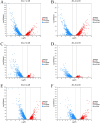Exogenous Trehalose Assists Zygosaccharomyces rouxii in Resisting High-Temperature Stress Mainly by Activating Genes Rather than Entering Metabolism
- PMID: 39728338
- PMCID: PMC11677697
- DOI: 10.3390/jof10120842
Exogenous Trehalose Assists Zygosaccharomyces rouxii in Resisting High-Temperature Stress Mainly by Activating Genes Rather than Entering Metabolism
Abstract
Zygosaccharomyces rouxii is a typical aroma-producing yeast in food brewing, but it has low heat resistance and poor proliferation ability at high temperature. Trehalose is generally considered to be a protective agent that helps stable yeast cells resist heat shock stress, but its functional mechanism for yeast cells in the adaptation period under heat stress is unclear. In this study, the physiological metabolism changes, specific gene transcription expression characteristics, and transcriptome differences of Z. rouxii under different carbon sources under high-temperature stress (40 °C) were compared to explore the mechanism of trehalose inducing Z. rouxii to recover and proliferate under high-temperature stress during the adaptation period. The results showed that high concentration of trehalose (20% Tre) could not be used as the main carbon source for the proliferation of Z. rouxii under long-term high-temperature stress, but it helped to maintain the stability of the cell population. The intracellular trehalose of Z. rouxii was mainly derived from the synthesis and metabolism of intracellular glucose, and the extracellular acetic acid concentration showed an upward trend with the improvement of yeast growth. A high concentration of trehalose (20% Tre) can promote the expression of high glucose receptor gene GRT2 (12.0-fold) and induce the up-regulation of HSF1 (27.1-fold), MSN4 (58.9-fold), HXK1 (8.3-fold), and other signal transduction protein genes, and the increase of trehalose concentration will maintain the temporal up-regulation of these genes. Transcriptome analysis showed that trehalose concentration and the presence of glucose had a significant effect on the gene expression of Z. rouxii under high-temperature stress. In summary, trehalose assists Z. rouxii in adapting to high temperature by changing gene expression levels, and assists Z. rouxii in absorbing glucose to achieve cell proliferation.
Keywords: Zygosaccharomyces rouxii; high-temperature adversity; proliferation; transcriptome; trehalose.
Conflict of interest statement
The authors declare no conflicts of interest.
Figures









Similar articles
-
High Glucose Is a Stimulation Signal of the Salt-Tolerant Yeast Zygosaccharomyces rouxii on Thermoadaptive Growth.J Fungi (Basel). 2024 Feb 28;10(3):185. doi: 10.3390/jof10030185. J Fungi (Basel). 2024. PMID: 38535194 Free PMC article.
-
Metabolic characteristics of intracellular trehalose enrichment in salt-tolerant Zygosaccharomyces rouxii.Front Microbiol. 2022 Aug 2;13:935756. doi: 10.3389/fmicb.2022.935756. eCollection 2022. Front Microbiol. 2022. PMID: 35983337 Free PMC article.
-
A new understanding: Gene expression, cell characteristic and antioxidant enzymes of Zygosaccharomyces rouxii under the D-fructose regulation.Enzyme Microb Technol. 2020 Jan;132:109409. doi: 10.1016/j.enzmictec.2019.109409. Epub 2019 Aug 16. Enzyme Microb Technol. 2020. PMID: 31731962
-
Co-culture with Tetragenococcus halophilus improved the ethanol tolerance of Zygosaccharomyces rouxii by maintaining cell surface properties.Food Microbiol. 2021 Aug;97:103750. doi: 10.1016/j.fm.2021.103750. Epub 2021 Jan 21. Food Microbiol. 2021. PMID: 33653523 Review.
-
Adaptive response and tolerance to sugar and salt stress in the food yeast Zygosaccharomyces rouxii.Int J Food Microbiol. 2014 Aug 18;185:140-57. doi: 10.1016/j.ijfoodmicro.2014.05.015. Epub 2014 May 25. Int J Food Microbiol. 2014. PMID: 24973621 Review.
Cited by
-
Trehalose enhances neuronal differentiation with VEGF secretion in human iPSC-derived neural stem/progenitor cells.Regen Ther. 2025 Jun 26;30:268-277. doi: 10.1016/j.reth.2025.06.012. eCollection 2025 Dec. Regen Ther. 2025. PMID: 40654519 Free PMC article.
References
-
- Jansen M., Veurink J.H., Euverink G.J., Dijkhuizen L. Growth of the salt-tolerant yeast Zygosaccharomyces rouxii in microtiter plates: Effects of NaCl, pH and temperature on growth and fusel alcohol production from branched-chain amino acids. FEMS Yeast Res. 2003;3:313–318. - PubMed
Grants and funding
LinkOut - more resources
Full Text Sources

